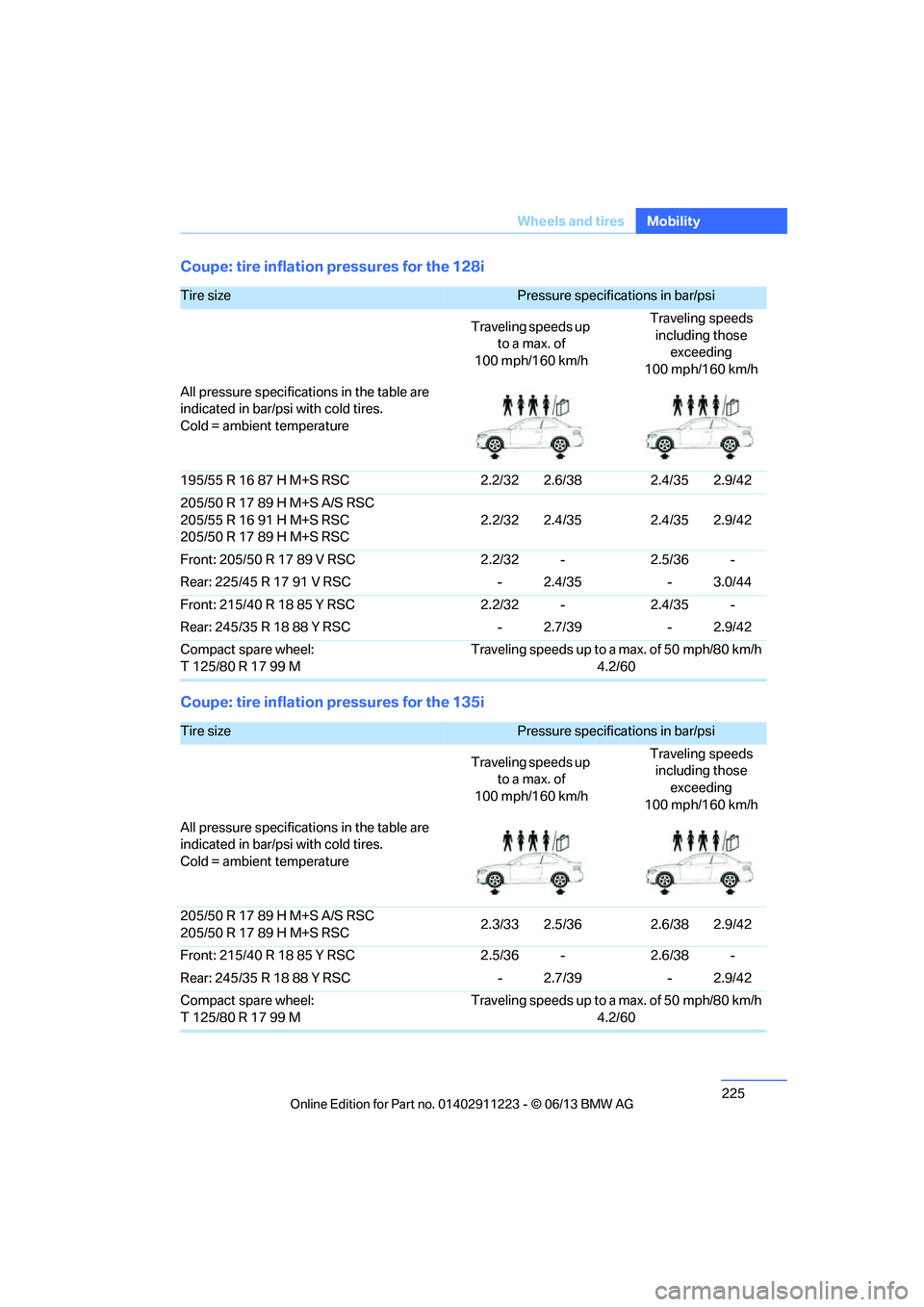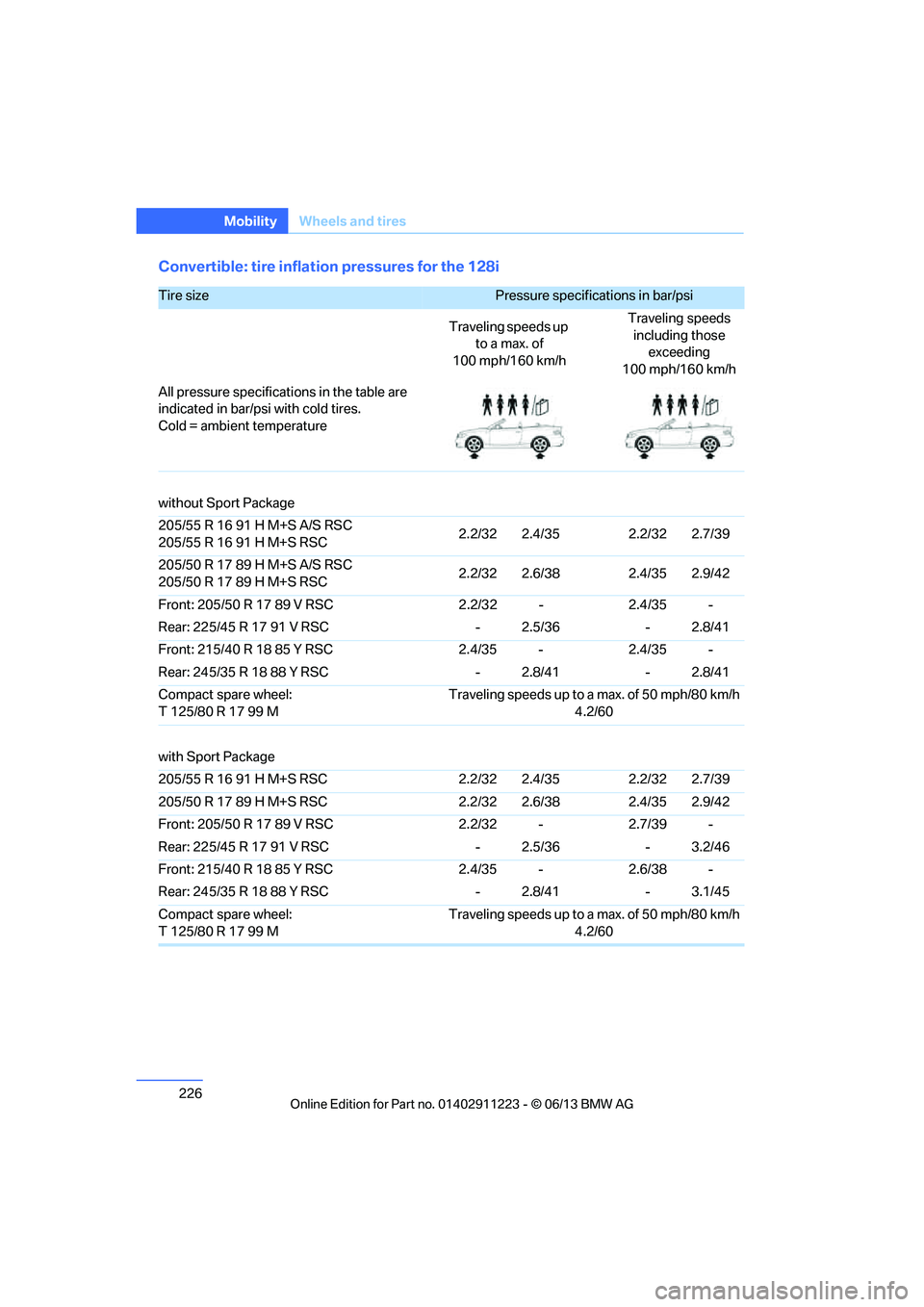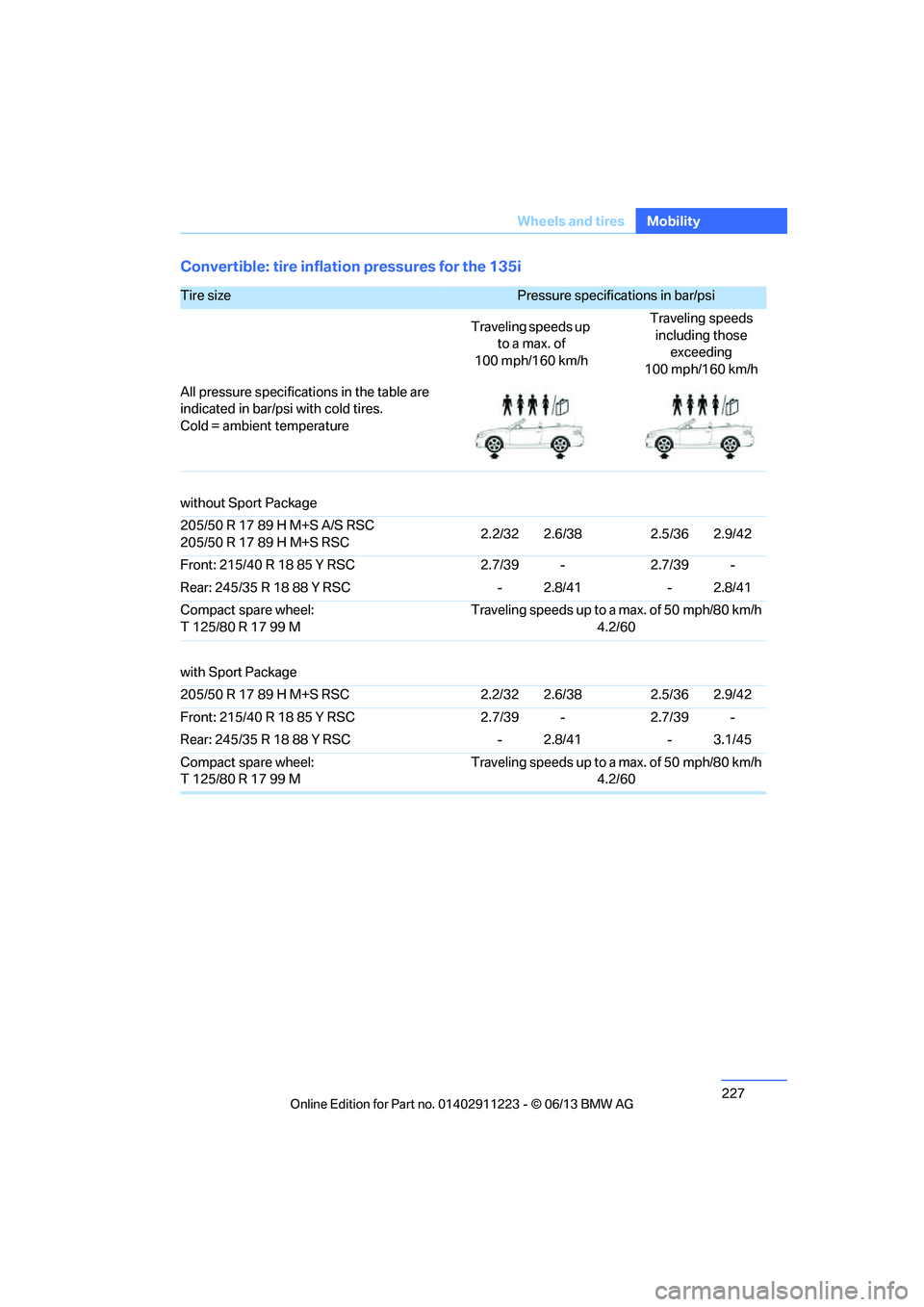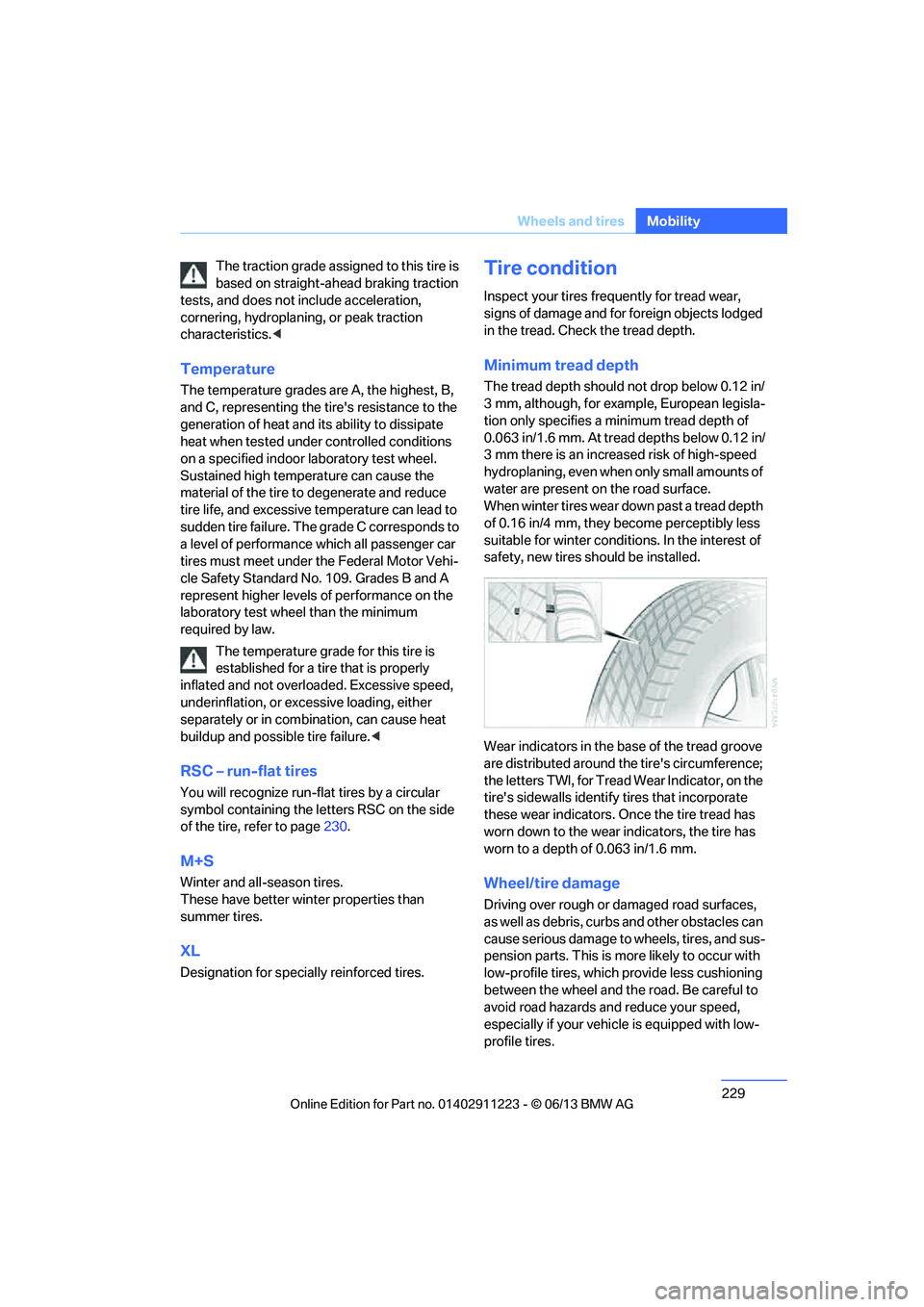2013 BMW 128I COUPE flat tire
[x] Cancel search: flat tirePage 226 of 284

225
Wheels and tires
Mobility
Coupe: tire inflation pressures for the 128i
Coupe: tire inflation pressures for the 135i
Tire size Pressure specifications in bar/psi
Traveling speeds up to a max. of
100 mph/160 km/h Traveling speeds
including those exceeding
100 mph/160 km/h
All pressure specifications in the table are
indicated in bar/psi with cold tires.
Cold = ambient temperature
195/55 R 16 87 H M+S RSC 2.2/32 2.6/38 2.4/35 2.9/42
205/50 R 17 89 H M+S A/S RSC
205/55 R 16 91 H M+S RSC
205/50 R 17 89 H M+S RSC 2.2/32 2.4/35 2.4/35 2.9/42
Front: 205/50 R 17 89 V RSC 2.2/32 - 2.5/36 -
Rear: 225/45 R 17 91 V RSC - 2.4/35 - 3.0/44
Front: 215/40 R 18 85 Y RSC 2.2/32 - 2.4/35 -
Rear: 245/35 R 18 88 Y RSC - 2.7/39 - 2.9/42
Compact spare wheel:
T 125/80 R 17 99 M Traveling speeds up to a max. of 50 mph/80 km/h
4.2/60
Tire size Pressure specifications in bar/psi
Traveling speeds up to a max. of
100 mph/160 km/h Traveling speeds
including those
exceeding
100 mph/160 km/h
All pressure specifications in the table are
indicated in bar/psi with cold tires.
Cold = ambient temperature
205/50 R 17 89 H M+S A/S RSC
205/50 R 17 89 H M+S RSC 2.3/33 2.5/36
2.6/38 2.9/42
Front: 215/40 R 18 85 Y RSC 2.5/36 -2.6/38 -
Rear: 245/35 R 18 88 Y RSC - 2.7/39- 2.9/42
Compact spare wheel:
T 125/80 R 17 99 M Traveling speeds up to a max. of 50 mph/80 km/h
4.2/60
00320051004F004C00510048000300280047004C0057004C005200510003
Page 227 of 284

226
MobilityWheels and tires
Convertible: tire inflation pressures for the 128i
Tire size Pressure specifications in bar/psi
Traveling speeds up to a max. of
100 mph/160 km/h Traveling speeds
including those exceeding
100 mph/160 km/h
All pressure specificat ions in the table are
indicated in bar/psi with cold tires.
Cold = ambient temperature
without Sport Package
205/55 R 16 91 H M+S A/S RSC
205/55 R 16 91 H M+S RSC 2.2/32 2.4/35 2.2/32 2.7/39
205/50 R 17 89 H M+S A/S RSC
205/50 R 17 89 H M+S RSC 2.2/32 2.6/38 2.4/35 2.9/42
Front: 205/50 R 17 89 V RSC 2.2/32 - 2.4/35 -
Rear: 225/45 R 17 91 V RSC - 2.5/36 - 2.8/41
Front: 215/40 R 18 85 Y RSC 2.4/35 - 2.4/35 -
Rear: 245/35 R 18 88 Y RSC - 2.8/41 - 2.8/41
Compact spare wheel:
T 125/80 R 17 99 M Traveling speeds up to a max. of 50 mph/80 km/h
4.2/60
with Sport Package
205/55 R 16 91 H M+S RSC 2.2/32 2.4/35 2.2/32 2.7/39
205/50 R 17 89 H M+S RSC 2.2/32 2.6/38 2.4/35 2.9/42
Front: 205/50 R 17 89 V RSC 2.2/32 - 2.7/39 -
Rear: 225/45 R 17 91 V RSC - 2.5/36 - 3.2/46
Front: 215/40 R 18 85 Y RSC 2.4/35 - 2.6/38 -
Rear: 245/35 R 18 88 Y RSC - 2.8/41 - 3.1/45
Compact spare wheel:
T 125/80 R 17 99 M Traveling speeds up to a max. of 50 mph/80 km/h
4.2/60
00320051004F004C00510048000300280047004C0057004C005200510003
Page 228 of 284

227
Wheels and tires
Mobility
Convertible: tire inflation pressures for the 135i
Tire size Pressure specifications in bar/psi
Traveling speeds up to a max. of
100 mph/160 km/h Traveling speeds
including those exceeding
100 mph/160 km/h
All pressure specifications in the table are
indicated in bar/psi with cold tires.
Cold = ambient temperature
without Sport Package
205/50 R 17 89 H M+S A/S RSC
205/50 R 17 89 H M+S RSC 2.2/32 2.6/38 2.5/36 2.9/42
Front: 215/40 R 18 85 Y RSC 2.7/39 - 2.7/39 -
Rear: 245/35 R 18 88 Y RSC - 2.8/41 - 2.8/41
Compact spare wheel:
T 125/80 R 17 99 M Traveling speeds up to a max. of 50 mph/80 km/h
4.2/60
with Sport Package
205/50 R 17 89 H M+S RSC 2.2/32 2.6/38 2.5/36 2.9/42
Front: 215/40 R 18 85 Y RSC 2.7/39 - 2.7/39 -
Rear: 245/35 R 18 88 Y RSC - 2.8/41 - 3.1/45
Compact spare wheel:
T 125/80 R 17 99 M Traveling speeds up to a max. of 50 mph/80 km/h
4.2/60
00320051004F004C00510048000300280047004C0057004C005200510003
Page 230 of 284

229
Wheels and tires
Mobility
The traction grade assigned to this tire is
based on straight-ahe
ad braking traction
tests, and does not include acceleration,
cornering, hydroplaning, or peak traction
characteristics. <
Temperature
The temperature grades are A, the highest, B,
and C, representing the ti re's resistance to the
generation of heat and its ability to dissipate
heat when tested under controlled conditions
on a specified indoor laboratory test wheel.
Sustained high temperature can cause the
material of the tire to degenerate and reduce
tire life, and excessive temperature can lead to
sudden tire failure. The grade C corresponds to
a level of performance which all passenger car
tires must meet under the Federal Motor Vehi-
cle Safety Standard No. 109. Grades B and A
represent higher levels of performance on the
laboratory test whee l than the minimum
required by law.
The temperature grade for this tire is
established for a tire that is properly
inflated and not overloaded. Excessive speed,
underinflation, or exce ssive loading, either
separately or in combin ation, can cause heat
buildup and possible tire failure. <
RSC – run-flat tires
You will recognize run-flat tires by a circular
symbol containing the letters RSC on the side
of the tire, refer to page230.
M+S
Winter and all-season tires.
These have better wint er properties than
summer tires.
XL
Designation for specia lly reinforced tires.
Tire condition
Inspect your tires frequently for tread wear,
signs of damage and for foreign objects lodged
in the tread. Check the tread depth.
Minimum tread depth
The tread depth should not drop below 0.12 in/
3 mm, although, for example, European legisla-
tion only specifies a minimum tread depth of
0.063 in/1.6 mm. At tread depths below 0.12 in/
3 mm there is an increased risk of high-speed
hydroplaning, even when only small amounts of
water are present on the road surface.
When winter tires wear down past a tread depth
of 0.16 in/4 mm, they be come perceptibly less
suitable for winter condit ions. In the interest of
safety, new tires sh ould be installed.
Wear indicators in the base of the tread groove
are distributed around th e tire's circumference;
the letters TWI, for Tread Wear Indicator, on the
tire's sidewalls identify tires that incorporate
these wear indicators. On ce the tire tread has
worn down to the wear indicators, the tire has
worn to a depth of 0.063 in/1.6 mm.
Wheel/tire damage
Driving over rough or damaged road surfaces,
as well as debris, curbs and other obstacles can
cause serious damage to wheels, tires, and sus-
pension parts. This is more likely to occur with
low-profile tires, which provide less cushioning
between the wheel and th e road. Be careful to
avoid road hazards and reduce your speed,
especially if your vehi cle is equipped with low-
profile tires.
00320051004F004C00510048000300280047004C0057004C005200510003
Page 231 of 284

230
MobilityWheels and tires
Unusual vibrations encountered during normal
vehicle operation can indicate tire failure or
some other vehicle defect. This can, for exam-
ple, be caused by driving over curbs. The same
applies to any other abnormal road behavior,
such as pulling severely to the right or left.
In these cases, reduce speed immedi-
ately and have wheels and tires thor-
oughly checked. To do so , drive carefully to the
nearest BMW center or tire dealer. If necessary,
have the vehicle towed there.
O t h e r w i s e , t i r e d a m a g e c a n p o s e a l e t h a l h a z a r d
to vehicle occupants and other road users. <
Tire age
For various reasons, such as the development
of brittleness, BMW recommends tire replace-
ment after no more than 6 years, regardless of
the actual wear of the tires.
The manufacturing date of tires is contained in
the tire coding:
DOT ... 1013 means that the tire was manufac-
tured in week 10 of 2013.
New wheels and tires
Have new wheels and tires mounted only
by your BMW center or by a tire dealer. If
this work is not carried out properly, there is a
danger of subsequent damage and related
safety hazards. Make sure that the new wheels
are balanced. <
Retreaded tires
BMW recommends that you do not use
retreaded tires, since driving safety may
be impaired. The causes for this include poten-
tially different tire casing structures and often
wide variations in tire ag e, which can result in a
limited service life. <
Correct wheels and tires
When mounting new tires or changing over
from summer to winter tires and vice versa,
mount run-flat tires for your own safety. In the
event of a flat, no spare wheel is available. Your
BMW center will be glad to advise you.
BMW recommends that you use only
wheel and tire combinations that BMW
has tested and approved for your particular
vehicle. Variations in factors such as manufac-
turing tolerances mean that even wheels and
tires with identical offi cial size ratings could
actually have different dimensions, which could
lead to body contact an d thus to severe acci-
dents. If non-approved wheels and tires are
used, BMW cannot evaluate their suitability,
and therefore cannot guarantee their driving
safety. <
You can inquire about the right wheel/tire
combination at your BMW center.
The correct combination of wheels and tires is
also necessary to ensure reliable operation of
various vehicle systems such as ABS, DSC or
FTM.
To maintain good handling and vehicle
response, use only tires of a single brand and
tread configuration. Af ter a tire has been
damaged, mount the previous wheel and tire
combination again as soon as possible.
Wheels with Tire Pressure Monitor
TPM electronics
When mounting new tires or changing over
from summer to winter tires, or vice versa, only
use wheels with TPM electronics; otherwise,
the Tire Pressure Monito r may not be able to
detect a puncture, refer to page 94. Your BMW
center will be glad to advise you.
00320051004F004C00510048000300280047004C0057004C005200510003
Page 232 of 284

231
Wheels and tires
Mobility
Recommended tire brands
Certain makes of tire are recommended by
BMW for each tire size. They are marked with a
clearly visible BMW designation on the sidewall
of the tire.
When properly used, these tires meet the high-
est standards in terms of safety and handling
characteristics.
Special characteristics of winter tires
BMW recommends winter tires for driving on
winter roads or at temperatures below +45
7/
+7 6. Although all-season M+S tires provide
better winter traction th an summer tires, they
generally fail to provide the same levels of cold-
weather performance as winter tires.
Pay attention to speed
Always comply with the speed limit for the
winter tires mounted on your car; failure
to do so could result in tire damage and
accidents. <
If the car is capable of speeds higher than that
permitted for the winter ti res, a label stating the
maximum permitted speed for the mounted
tires must be displayed in your field of view.
Specialist tire dealers and your BMW center
can supply these labels.
Storage
Store wheels and tires in a cool, dry place with
as little exposure to light as possible. Always
protect tires against all co ntact with oil, grease
and fuels.
Do not exceed the maximum tire inflation
pressure indicated on th e sidewall of the tire.
Swapping wheels between axles
BMW advises against swapping wheels
between the front and rear axles, even if all tires
have the same size, as th is could impair driving
characteristics. If the tires are of mixed sizes,
swapping wheels between the axles is not
permissible.
Run-flat tires
The symbol identifying run- flat tires is a circle
with the letters RSC on the sidewall.
Run-flat tires comprise a conditionally self-
supporting tire and a special rim. The reinforce-
ment in the sidewalls en sures that the tire can
continue to be used su bject to certain restric-
tions, even if depressurized.
For information on continuing to drive with a flat
tire, refer to Indication of a flat tire on page92.
Snow chains
Only certain fine-link snow chains have been
tested by BMW, classified as safe for use and
recommended. Consult your BMW center for
more information. Snow chains must be
mounted in pairs and on the rear wheels only.
Observe the manufacturer's instructions when
mounting snow chains. Do not exceed a speed
of 30 mph/50 km/h with chains.
Do not initialize the Flat Tire Monitor if
snow chains are mounted; otherwise, the
instrument might issue an incorrect reading.
When driving with snow chains, you may find it
helpful to activate DT C temporarily, refer to
page 89.<
00320051004F004C00510048000300280047004C0057004C005200510003
Page 249 of 284

248
MobilityReplacing components
Changing wheels
Your BMW is equipped with run-flat tires as
standard. This eliminates the need to change a
wheel immediately in the event of a puncture.
For information on continuing to drive with a
damaged tire, refer to Indica tion of a flat tire on
page 92.
The symbol identifying run- flat tires is a circle
with the letters RSC on the sidewall, refer to
New wheels and tires, page 230.
When mounting new tires or changing over
from summer to winter tires and vice versa,
mount run-flat tires for your own safety. In the
event of a flat, no spare wheel is available. Your
BMW center will be glad to advise you. Refer
also to New wheels and tires, page 230.
The tools for changing wheels are avail-
able as optional accessories from your
BMW center. <
Jack mounting points
The jacking points are at the positions shown in
the illustration.
Vehicle battery
Battery care
The battery is 100 % maintenance-free, the
electrolyte will last for the life of the battery
when the vehicle is operated in a temperate
climate. Your BMW center will be glad to advise
in all matters conc erning the battery.
Battery replacing
Only use vehicle batteries that have been
approved for your vehicle by the manu-
facturer; otherwise, the vehicle could be dam-
aged and systems or functions may not be fully
available. <
After a battery replacem ent, have the battery
registered on the vehicle by your service center
to ensure that all comfort functions are fully
available.
Charging the battery
Note
Do not connect battery chargers to the
sockets installed in the vehicle at the
factory; otherwise you may cause damage to
the battery. <
General information
To guarantee the full serv ice life of the battery,
ensure that the battery is always properly
charged.
It may be necessary to ch arge the battery in the
following situations:
> If frequent short trips are taken;
> If the vehicle is frequently parked for more
than a month.
Jump-starting terminals
Charge the battery via the connections in the
engine compartment only when the engine is
off. Connections, refer to Jump starting on
page 251.
Power failure
After a temporary power lo ss, the functioning of
some equipment may be limited and require
reinitialization. Individual settings may likewise
have been lost and will have to be programmed:
> Time and date
These values must be updated, refer to
page 82.
00320051004F004C00510048000300280047004C0057004C005200510003
Page 269 of 284

268
ReferenceEverything from A to Z
Everything from A to Z
Index
A
ABS Antilock Brake
System 89
Acceleration assistant, refer to Launch Control 70
Accessories, refer to Vehicle equipment 5
Accident, reporting, refer to
Emergency Request 250
Activated-charcoal filter 109
Active steering 96
Adaptive Light Control 101
Additives
– coolant 235
– engine oil 235
Address, entering 134,140
Address for navigation
– entering 134
Adjusting temperature 107
Airbags 97
– sitting safely 49
– warning lamp 98
Air conditioner 106
Air distribution
– automatic 107
Airing, refer to Ventilation 109
Air outlets, refer to Air vents 106
Air pressure, checking, refer to Tire inflation
pressure 223
Air recirculation, refer to Recirculated air mode 108
Air vents 106
Air volume 108
AKI, refer to Fuel grade 221Alarm system
38
– avoiding unintentional alarms 40
– interior motion sensor 39
– switching off an alarm 39
– tilt alarm sensor 39
Albums in music collection 175
ALL program 108
All-season tires, refer to Winter tires 231
AM, waveband 157
Ambient air, refer to Recirculated air mode 108
Antifreeze
– coolant 235
– washer fluid 72
Antilock Brake System
ABS 89
Anti-theft alarm system, refer
to Alarm system 38
Appointments, refer to Calendar 207
Approved axle loads, refer to Weights 259
Approved engine oils 235
Approved gross vehicle weight, refer to W
eights259
Apps 216
Armrest, refer to Center armrest 115
Arrival time
– computer 78
Ashtray 116
Assistance systems, refer to
Dynamic Stability Control
DSC 89 AUC Automatic recirculated
air control 108
Audible instructions, refer to
Voice instructions 145
Audio 154
– controls 154
– switching on/off 154
– tone control 155
– volume 155
Automatic
– air distribution 107
– air volume 107
– cruise control 73
– headlamp control 100
Automatic car washes 239
Automatic climate control 106
Automatic curb monitor 56
Automatic high beams and
low beams, refer to High-
beam Assistant 102
Automatic lamps
– refer to Welcome lamps 101
Automatic recirculated air
control AUC 108
Automatic Service Request 215
Automatic transmission with Steptronic 64
– selector lever lock 64
– shiftlock 64
– towing 252
– tow-starting 252
AUTO program for automatic climate control 107
AUX-In connection 177
Available services 216
Average fuel consumption 77
– setting the units 80
00320051004F004C00510048000300280047004C0057004C005200510003